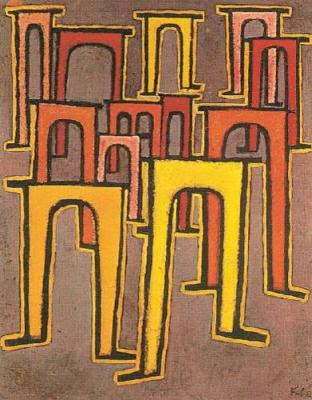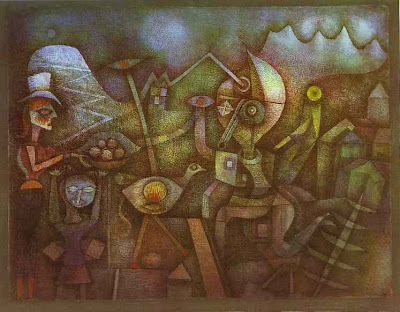Kuakistar13 wrote:One thing I think is weird is the continuing attempt to "define" art. It seems to me the point of any art piece is to defy previous expressions

Heh heh, true.
---
Ok I liked searching web for representative Mondrian pieces so I figured I could do the same for Paul Klee.
Ok well, he's certainly a painter whose works lose the least in books of reproductions being that his works are usually in small format so when they allow to be printed in a book in original format. Not that it replaces seeing them in original. Lots of them are in his foundation museum in Bern. Twittering Machine, I think, is in New York:

I've read dozens of different interpretations of his works over the years, one thing that they all share is impression that Klee must be one of the most philosophical, spiritual painters of his era. Being that he was a teacher in Bauhaus, he developed a very complicated system of believs about art - he was not too interested in teaching techniques, though that's probably not what he was brought in for anyway.
His teaching notes have been published and I've read them - not that I understood most of it, it was several years ago and stuff was pretty abstract, but basis of it is that elements of art like dots, lines and surfaces are elemental forces that have life of their own and form meanings on their own.
This was incorporated into his creative process. For instance, often, he's work on canvas surface very long, until some subject arised from the surface by itself. Other times, his paintings would start life practically as phone doodles. Example of the former is "Senecio":

Which, I think, started as a patchy doodle of a man's face, and later work on the surface gave it that rustic look.
Example of the former is Fruchte Auf Rot:

It was executed on his violin hankerchief. Over the time, lines and spots appeared on the hankerchief from the use, and he recognized a mothive in these lines and finished the painting.
Similar case was with Red Baloon, where he used natural seams from one found piece of cloth as a basis for his painting:

Then there's Refuge:

It's one of my personal favourites. At first sight, figure in the middle is taken as a creature, half of human body, and curtains above suggest that he's on a theatre stage. The more you look, the more figure looks like a swimmer, and curtains actually become sea waves.
I think that the reason I liked Klee from start was the variety of styles, techniques and moods he was working in. He's an artist for whom you can't find one representative style, rather you can point at numerous styles which are all unmistakeably his own.
Case in point you have simple stream-of-the-consciousness pieces:

You have paintings which were pure exploration of colour, often attempts to represent musical forms through painting:


 http://wahooart.com/A55A04/w.nsf/OPRA/B ... e-_sum.Jpg
http://wahooart.com/A55A04/w.nsf/OPRA/B ... e-_sum.Jpg
His very symbolic "landscapes":


His "scratchy" paintings in the vein of "Twittering machine":

(strange enough, one friend took the cross in the background to be symbolic of Klee's religious tendencies... I always thought it was there to symbolize stability)

Paintings with plenty of cross-hetching in the vein of "Refuge":


His famous viaducts:

Which are often taken as representation of incoming fascism, though I've read interpretation which claims that archs actualy symbolise creativity and disorder which are to opose to fascism.
His later paintings in which he turned landscapes into systems of symbols:



And then paintings which you just can't compare to anything else:

From the simplest

to the most elaborate:

Literally, whenever I though I saw all Klee's faces, I'd find about a painting of his that looks like nothing of his I've seen before.
Other strong thing is his suggestive power.

In "Storm over the city", sprayed background and the doodle in the foreground may mean various subjects, but what really triggers the interpretation, what makes us see the work as what is written in the title, is that one little roof over there, because of it, everything else in the painting clicks into place and allow us to see painting as representation of actual scene.
That's the thing that impresses me. Often, it's one or two signs that turn bunch of abstract lines and tones into a representational painting.
Near his death he was still painting but his lines weren't as lively, his subjects were darker and techniques were rougher, sometimes pigment applied to the canvas by finger.

One can attribute this to his declining health, but it was definitely appropriate - title of this painting is Death and Fire, and painting is as if executed by a dying man - whether by choice or by circumstance, it is perfect.
But the great piece that he made short before his death was Kettle-drummer:

Drummer is made of only two sticks and one eye. The rough brushes, the two red spots, the simplicity, everything says that drummer is counting off moments till death.
One thing that's always been fascinating to me is that an artist who became known for childlike playful paintings, paintings of puppet theatres and folk tale atmosphere, started his career with a series of rather morbid etchings:

One day I'll definitely make a comic based on this perspective:



































